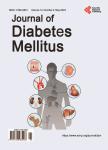The Relationship between Hypoglycaemic Episodes and Arrhythmias in Type 2 Diabetes Subjects after Acute Myocardial Infarction with ST-Segment Elevation—A Case Series
The Relationship between Hypoglycaemic Episodes and Arrhythmias in Type 2 Diabetes Subjects after Acute Myocardial Infarction with ST-Segment Elevation—A Case Series作者机构:Department of Diabetes Nutrition and Metabolic Diseases Carol Davila University of Medicine and Pharmacy Bucharest Romania Department of Cardiology Carol Davila University of Medicine and Pharmacy Bucharest Romania Clinical Emergency Hospital of Bucharest Bucharest Romania
出 版 物:《Journal of Diabetes Mellitus》 (糖尿病(英文))
年 卷 期:2022年第12卷第2期
页 面:141-152页
学科分类:1002[医学-临床医学] 100201[医学-内科学(含:心血管病、血液病、呼吸系病、消化系病、内分泌与代谢病、肾病、风湿病、传染病)] 10[医学]
主 题:CGMS Hypoglycaemia STEMI Glycemic Variability
摘 要:Background and Aims: Several studies have shown that hypoglycaemia, especially a severe episode is associated with an increased mortality rate in diabetes mellitus subjects with previous cardiovascular disease or acute coronary syndrome. One of the presumed mechanisms is the proarrhythmic effect of hypoglycaemia related to the prolongation of the action potential, or the catecholamine surge that follows an episode. The aim of this case series analysis was to investigate the relationship between hypoglycaemia and glucose variability with arrhythmic events in type 2 diabetes patients who suffered an acute myocardial infarction. Materials and Methods: We selected patients admitted consecutively to the cardiology department of Clinical Emergency Hospital in Bucharest for a period of three months with acute myocardial infarction and previously diagnosed type 2 diabetes. For each patient, a retrospective continuous glucose monitoring system (CGMS) or glucose sensor (Medtronic® Enlite, USA) and a dual electrocardiograph and blood pressure monitor for 24 hours were available. Also, patients had an oscillometric device (Arteriograph® TensioMed Ltd) for 24 hours or non-invasive monitoring of central blood pressure, pulse wave velocity and augmentation index. The data were analysed using Medtech®, TensioWin® and Carelink iPro® softwares. We used SPSS® version 20.0 (IBM) for the statistical analysis. The results are presented as median and interquartile range (IQR). Results and Discussion: Ten type 2 diabetes patients (4 males, 6 females) with anterior (4/10) and inferior acute myocardial infarction (6/10) were included. They were treated with insulin (3/10), sulphonylurea (Gliclazide) plus Metformin (4/10), Metformin monotherapy (2/10), or all three (1/10). The patients had a median age of 67.5 (3.25) years with a median disease duration of 8 (7.75) years. The median body mass index was 2



